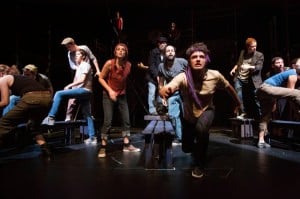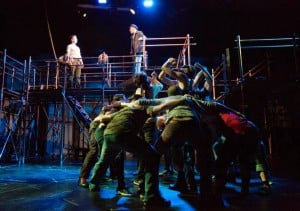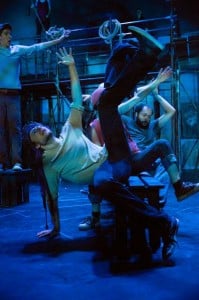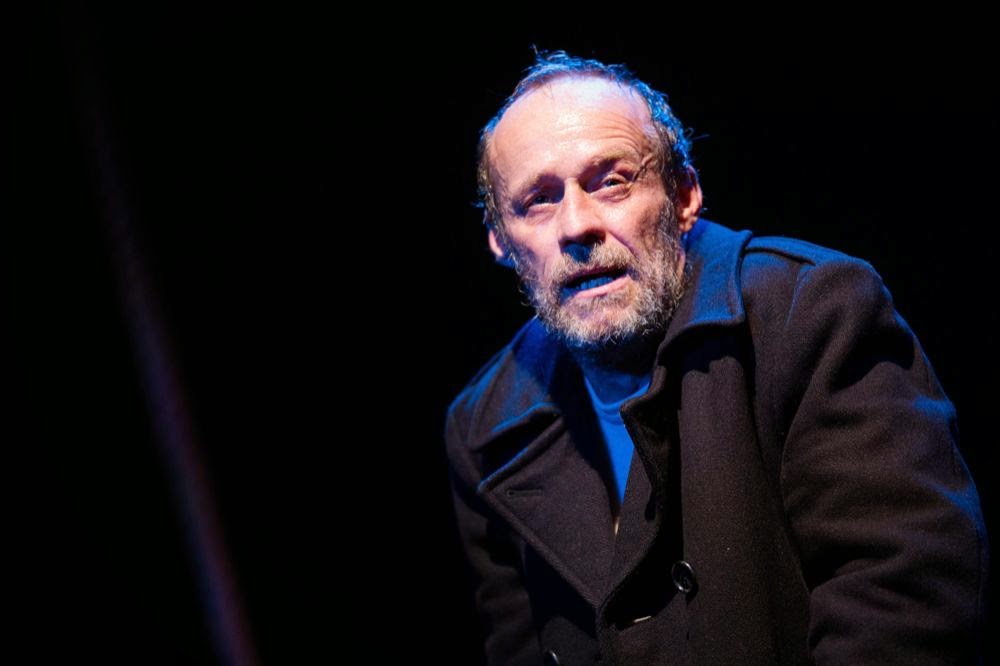
The mention of “Moby Dick” might call to mind the image of a fearsome white whale, glittering harpoons and roiling waves. It may be surprising, then, that the set of “Moby Dick — Rehearsed,” performed by the Stanford Repertory Theater (SRT) and directed by Rush Rehm, contains none of these things.
The first production in the SRT’s summer festival, Orson Welles: Substantial Shadows, the production celebrates Welles’ outstanding cinematic career and the short drama he wrote based on Herman Melville’s classic “Moby Dick.” This unique rendition relies on the bare minimum of props, a dynamic cast and the audience’s imagination to conjure the setting of a vast ocean filled with whales and venturesome sailors.
At the start of the play, a motley group of actors dressed in street clothes clusters onstage, grumbling about its director’s (Courtney Walsh) bizarre ideas about theater. After a few uninspired (and rather amusing) attempts at rehearsing Shakespeare’s “King Lear,” they give up and instead begin reading the script for “Moby Dick — Rehearsed” that one of the actors, an aspiring playwright (Louis McWilliams), has written.

The playwright emerges as Ishmael and begins the narration. After a few funny attempts from the stage manager (Kaya McRuer) to get some sound effects for the docks, the sweet tune of a harmonica fills the auditorium, transporting us to a wharf in a town by the sea.
Some of the actors lift plain white panels from the background to reveal a tall structure of wooden poles that spans across the stage and will serve as the “Pequod,” Captain Ahab’s (Rod Gnapp) trusty ship. Throughout the play, the actors saunter across the decks, hang from the hammocks or perch at the crow’s nest of this makeshift ship. These set pieces become extraordinarily useful in the absence of a backdrop. The only other major props are a few wooden benches that are used as tables, benches, chairs and harpooning boats. One of the standout aspects of this production, in fact, is its resourceful use of drama and imagination to create the setting, rather than ostentatious scenery and elaborate props.
The chapel scene from the novel is recreated by turning over the benches into pews and a pulpit. The actors sing a lovely hymn, their voices blending harmoniously together. A preacher (Courtney Walsh) expounds on the biblical story of Jonah and the whale, declaring that one should cling to God despite adversity, a theme that will reappear later on as Ahab repeatedly declares that no force can stop him from his pursuit of Moby Dick. Ishmael then encounters a crazy sailor named Elijah (Dante Belletti), who warns him against joining Ahab’s crew because of the treacherous life that whalers lead. Elijah sports a black hoodie that seems like normal streetwear but for the white skull graphic on the back, which augurs the ocean’s perils. This is just one of the many thoughtful details in costuming that relates each supposedly modern-day character to his or her character in the novel; for instance, Captain Ahab’s first mate, Starbuck (Peter Ruocco), appears to be holding a Starbucks drink at the start of the play.

When the crew sights its first whale of the voyage, Captain Ahab summons Starbuck. This scene perfectly depicts Ahab’s iron will, which stops him from listening to the reasoning of his more thoughtful and prudent first mate. It is the first the audience sees of Ahab’s bitter attitude, his insatiable desire for vengeance on the whale that took his leg so many years ago. Despite his queer personality, however, Ahab effectively rallies his crew, promising a gold coin to the first man to spot the white whale Moby Dick. Gnapp’s portrayal of Ahab is spot on, from the painful limp to his mercurial temper to his insatiable thirst for revenge.
Gnapp’s impeccable performance characterizes Ahab as a deeply troubled captain blind to everything else but his goal of slaying Moby Dick. The image of Ahab is further rounded out by other crew members’ conversations about their eccentric leader, as well as by Ahab’s own ruminations: He admits that though he may die on the voyage, he believes it is his destiny to hunt down the malignant whale. Despite his hostile manner, Ahab forges a surprising connection with young Pip (Maia Kazin), a boy who became addled after nearly drowning in the ocean.

The only flaws of the play were some dragging parts: the disgruntled “King Lear” actors at the beginning, parts of the ship’s journey and some of the long conversations among shipmates or between Ahab and Pip. Pip, though extremely in character, was at times overly dramatic. On the other hand, the other sailors were represented as more of a collective group of crew members, rather than the distinct personalities they are in the book. Queequeg (Andre Amarotico), for instance, has a much smaller role in Welles’ drama than he does in Melville’s novel. Welles’ choice to tone down the other sailors’ back stories and instead spotlight Ahab’s and Pip’s relationship is interesting, putting a heavier focus on the cabin boy who plays a less significant role in the book. This, however, helps the audience notice perhaps the one human connection Ahab has and the lonely captain’s capacity to show compassion to a boy destroyed by the unforgiving ocean.
The SRT’s production of “Moby Dick — Rehearsed” retains the essence of Melville’s renowned story, but it brings in modern elements, reworking the whole novel through the power of theater. Moby Dick, the great and terrible force that propels the actions of Ahab and his crew, is never physically portrayed during the performance. But the whale’s powerful presence and the fear that he inspires are very palpable, thanks to the clever use of lighting, sound effects and convincing performances of the actors. The resourceful use of props, the cast’s admirable talent and portrayal of the characters with passionate abandon made the performance a spectacular tribute to Welles’ drama and Melville’s original novel, as well as a distinctive and remarkable entity all of its own.
The play runs Thursdays, Fridays and Saturday at 8p.m. and Sundays at 2 p.m. until August 10 at Pigott Theater, Memorial Auditorium. You can purchase tickets here.
